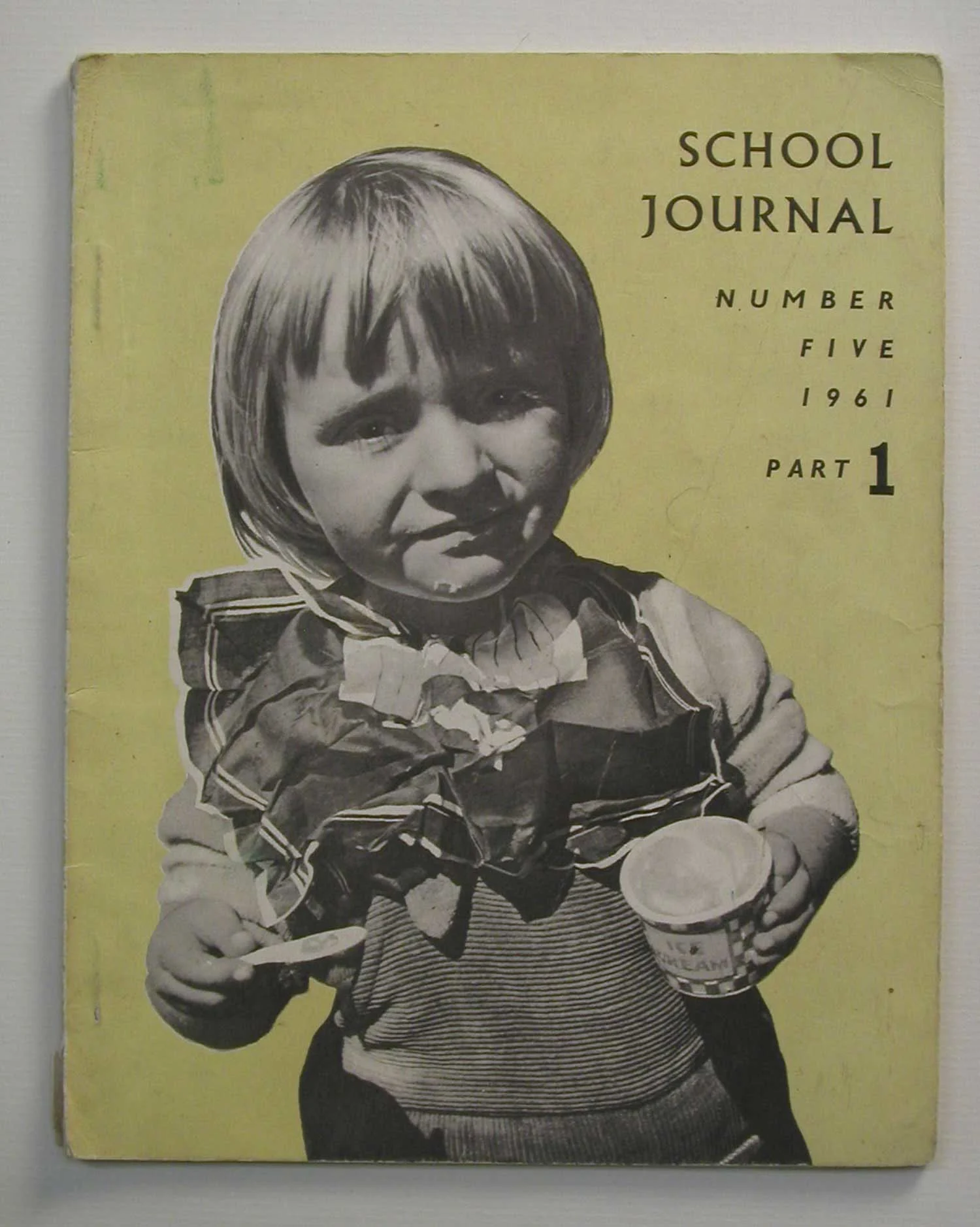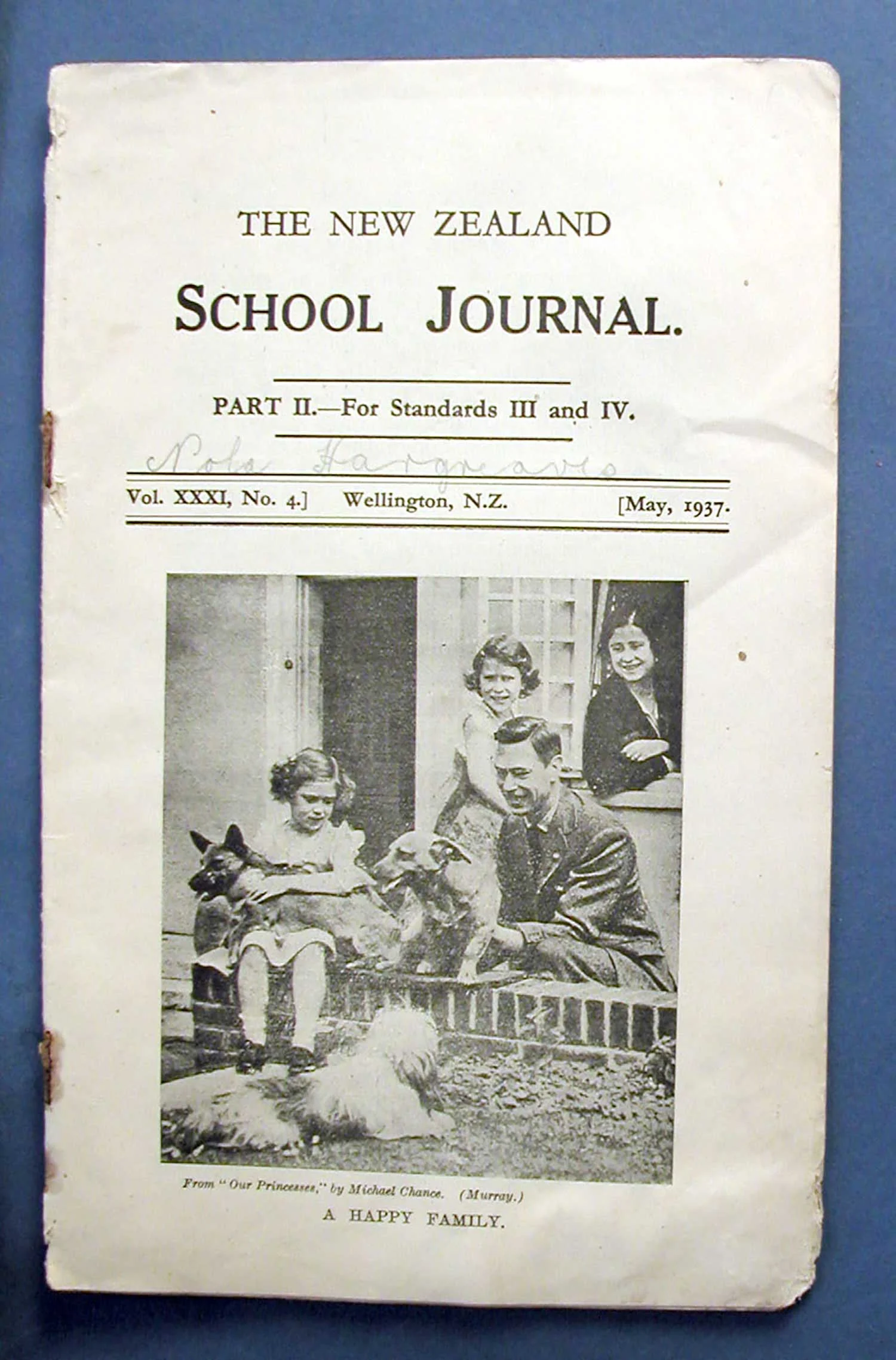Te Hītori o Ngā Whakaputanga Kura
History of the School Publications
Read a detailed history of the School Publications including the ‘School Journal’ — believed to be the longest-running serial publication for children in the world.
The School Publications Branch
In 1907, the first ‘School Journal’ was published followed in 1939 by the establishment by the New Zealand Department of Education of a publishing branch, which became known as the School Publications Branch.
-
Text Transcript
[Soft music plays in the background.]
It's May 1907, and for the first time school children throughout New Zealand are issued with a free publication containing information on history, geography and civics, replacing the need for separate textbooks.
The School Journal is the brainchild of Education Inspector General George Hogben and it will become a cornerstone of New Zealand education for over 100 years.
Many of those who contributed illustrations and text would become some of the country's most influential writers and artists.
The School Journals taught generations of school children about our country and our view of ourselves.
From 1993 other School Publications would be produced by Learning Media Te Pou Taki Korero. And the best of our artists and writers would continue to contribute their unique perspectives on our way of life.
How do we know this? Because it's in the archives.
[The coloured logo of Te Rua Mahara o te Kāwanatanga Archives New Zealand moving from the right to the centre of the video.]
Initially, the School Publications Branch focused on producing textbooks and other resources for primary and secondary schools. The Branch is best known for ‘School Journal’, a magazine style publication designed to promote literacy and engage young readers.
Other publications include:
‘Ready to Read’ — a series of graded readers first published in 1967 and still in print today, designed to help children develop their reading skills.
‘Junior Journal’ — founded in 1973 and still in creation now. It is similar to the ‘School Journal’ but aimed at younger readers.
‘Connected’ — started off as a print resource focusing on science and is now series of print and digital resources that support the New Zealand Curriculum, first published in 2010. These resources include interactive activities, videos and other multimedia content, designed to engage students and enhance their learning.
The ‘School Bulletin’ — a monthly publication, aimed at teachers, produced from 1922 to 1961.
‘Story Library’ — a range of story collections created from the 1930s to the 1960s, containing stories by New Zealand and international authors for children aged 8 to 12.
-
![Coloured illustration of a boy wearing a red shirt and a blue hat, on a bright yellow background and words written on the left ' Where is Timothy?'.]() Click to expand‘Ready to Read’ cover for ‘Where is Timothy?’
Click to expand‘Ready to Read’ cover for ‘Where is Timothy?’Photo credit: School Publications Branch, Department of Education, New Zealand
![Coloured illustration of a boy wearing a red shirt and a blue hat, on a bright yellow background and words written on the left ' Where is Timothy?'.]() Click to expand‘Ready to Read’ cover for ‘Where is Timothy?’
Click to expand‘Ready to Read’ cover for ‘Where is Timothy?’Photo credit: School Publications Branch, Department of Education, New Zealand
-
![Coloured illustration of a young boy wearing a red shirt and walking, holding his mother's hand, on a blue background with words written on the left 'Christmas shopping'.]() Click to expand‘Ready to Read’ cover for ‘Christmas Shopping’
Click to expand‘Ready to Read’ cover for ‘Christmas Shopping’Photo credit: School Publications Branch, Department of Education, New Zealand
![Coloured illustration of a young boy wearing a red shirt and walking, holding his mother's hand, on a blue background with words written on the left 'Christmas shopping'.]() Click to expand‘Ready to Read’ cover for ‘Christmas Shopping’
Click to expand‘Ready to Read’ cover for ‘Christmas Shopping’Photo credit: School Publications Branch, Department of Education, New Zealand
These are just a few examples of the many publications produced by the School Publications Branch and its successors over the years. The focus of these publications has always been on producing high-quality, locally relevant educational resources that meet the needs of New Zealand students and teachers.
This website showcases artworks from well-known New Zealand artists who contributed artworks to the School Publications. The majority of artworks were produced for the ‘School Journal’ and eventually transferred to Te Rua Mahara o te Kawanatanga Archives New Zealand (Archives NZ).
Here, you'll learn about the history behind School Publications and how the artworks were transferred to Archives NZ. You can also find information about some of the artists who contributed to the journals and see some of the artworks themselves.
The beginnings: ‘School Journal’
Now an iconic artefact of Aotearoa New Zealand’s rich cultural heritage, the 'School Journal' began its life as an idea. The concept was simple but timeless — to get children reading.
At the turn of the last century, against a peaceful pre-war backdrop, New Zealand was minding its own business at the bottom of the world. The news was little and local, and the national mood was one of growth — a perfect climate to birth new projects.
In 1907 a group of educators recognised the need for the children of the newly named Dominion to have their own literary resource. The early ‘School Journal’, spearheaded by Minister for Education William Pember Reeves, was as Greg O'Brien states in his book about the ‘School Journal’, ‘A Nest of Singing Birds’, states:
"resembled a traditional English reader, and much of the material was culled from imported literary sources"
What the ‘School Journal’ is
From its inception, the ‘School Journal’ provided a universally accessible, free literary education for children of all ages across Aotearoa New Zealand. It has also offered one of the most constant employment opportunities for Kiwi artists for over a hundred years. Unlike similar publications worldwide, the ‘School Journal’ has always been made available to all learners, in every school across the country, funded entirely by the government. Designed to foster a love of reading in every child, it has held a wide appeal from its inception until the present day.
In more recent decades, accompanying the print publications was an audiovisual offering (for example, interactive CD-ROMs) which helped to make the content accessible to all learners. This was a huge contributor to language and literacy development for struggling readers, non-English speakers and bilingual children.
Publishing
Always under the umbrella of the Department of Education, in 1989 the School Publications Branch became a crown-owned company called Learning Media. In 2005 Learning Media became state-owned and in 2013 it was dissolved, and the publications were handed back to the Ministry. A publishing agreement was formed with Lift Education, a company made up of many former Learning Media employees. Lift Education continues to edit the Journal as well as accompanying publications such as the ‘Junior Journal’ and ‘Connected’, in alignment with the New Zealand Curriculum learning objectives.
Originally the Journal catered for 4 age groups with the ‘Junior Journal’ for early readers. It was published quarterly and, while detailed, was a slim booklet full of hand-drawn illustrations and carefully arranged texts, designed to educate and entertain. It is now published biannually but is much bigger — around 48 pages.
A transforming landscape
The Journal has been a chameleon to the decades, but constants have been a local focus, a passionate long serving team of publishers and a focus of the child at the heart of every page.
Over the last one hundred plus years, the Journal has shifted and changed to reflect the evolving culture of a nation growing into itself. In its infancy, it felt the full force of the First World War and lost a little of its character while it hid in foreign trenches. In these years it reverted from its original voice to an imported nationalist sensibility. Patriotic pages dripping with King and Country. During the 20s and 30s the Journal returned to the safety of its educational roots, focusing on grammar and spelling, with anonymous contributors and sparse illustrations.
It wasn’t until the Second World War was over that the Journal, now past the awkward adolescent years, really came into itself. Education Minister Pember Reeve’s influence was retreating and under the directorship of Clarence Beeby, the establishment of the School Publications branch of the Ministry of Education in 1939 gave the Journal a new lease of life. Perhaps reflecting a global grief and need to find new hope — relevant today in our post-pandemic years — the Journal looked outward, to the dynamic worlds of art and literature, for new inspiration.
With a lifting of wartime printing restrictions and an influx of submissions from writers and artists at the precipice of their careers, the publications reflected a bustling arts scene finding its feet.
A wide consensus is that the 1950s to the early 2000s saw the heyday of the ‘School Journal’. Aesthetically it went from black and white, to coloured covers, to full multicolour over these decades. Thematically the contents oscillated depending on both the editors’ vision and the cultural landscape of the time. The 60s saw a serious social studies focus with non-fiction and photography coming to the fore. While a return to poetry and illustrations in the 1980s reflected a wider cultural tendency toward the imaginative.
It was also during this time that the Journal really found its own voice, becoming almost entirely Kiwi in content. It was the first publisher of Pasifika stories for the classroom and a leading publisher of Māori stories. While this bicultural focus was certainly not without blunders, it was a strong departure from its early beginnings that pushed a colonial agenda.
In the 1990s and early 2000s the Journal and other Ministry publications embraced the advancement in printing and technology. The attitude and content also shifted to reflect the everyday experiences of children in Aotearoa New Zealand. The modern ‘School Journal’ and other offerings continue this legacy while responding to wider cultural questions, events and challenges.
A few examples of modern content include Te Wharekura, Te Tautoko, Te Wharekura is a series of resources introduced in the early 2000s to support the teaching of te reo Māori in schools. Māori language publications are now produced by other publishers such as Huia, rather than Lift, but Lift do still publish Pacific publications such as Pacific language series, 'Tupu', in a number of different Pacific languages such as Tokelauan, Niuean, Samoan and Tongan.
Learning Media
The 1989 creation of separate publishing company Learning Media was a vote of confidence for the Ministry's Publications, by this time a national taonga. For the staff that worked there, Learning Media is fondly remembered as a pioneering workplace with a sense of community that many organisations strive for.
Given the accessibility of Learning Media, publishing was not only an option for well-known artists but also for those just starting their careers. The process was a conversation between first time contributors, seasoned editors, visual artists, educators, designers and the children themselves. Learning Media was a hub for those artists. There was a bustle to the business of putting together a publication. It was a collaborative effort from start to finish and most uniquely — given the relative youth of the New Zealand publishing industry — an educational process for everyone involved.
-
![Black and white photo of a young girl holding an ice cream cup and spoon on a pale yellow background]() Click to expandSchool Journal Number 5, 1961 - Part 1
Click to expandSchool Journal Number 5, 1961 - Part 1Photo credit: Collection of Auckland Museum Tāmaki Paenga Hira, 1999.144.77
![Black and white photo of a young girl holding an ice cream cup and spoon on a pale yellow background]() Click to expandSchool Journal Number 5, 1961 - Part 1
Click to expandSchool Journal Number 5, 1961 - Part 1Photo credit: Collection of Auckland Museum Tāmaki Paenga Hira, 1999.144.77
-
![Black and white photo of a family with dad, mum, 2 girls and 3 dogs on an old yellowed paper]() Click to expandSchool Journal - Part 2, Standard 3&4; Apr 1937
Click to expandSchool Journal - Part 2, Standard 3&4; Apr 1937Photo credit: Collection of Auckland Museum Tāmaki Paenga Hira, 1999.144.13
![Black and white photo of a family with dad, mum, 2 girls and 3 dogs on an old yellowed paper]() Click to expandSchool Journal - Part 2, Standard 3&4; Apr 1937
Click to expandSchool Journal - Part 2, Standard 3&4; Apr 1937Photo credit: Collection of Auckland Museum Tāmaki Paenga Hira, 1999.144.13
At its peak in the early 2000s Learning Media was one of Australasia's largest design studios, employing around 15 full time designers. Publication represented a real mark of success for artists of all persuasions. For many, it was the only source of paid work in the early stages of their careers.
The closure of Learning Media in 2012 gave way to a new chapter for School Publications but the close-knit culture of those key decades has helped shape values that guide their creation to this day.
Challenges for School Publications
Over the decades, the production of the Journal and other Ministry publications has not been free from challenges. From the freedom of the earlier years, where poets would scribble their contributions on the backs of receipts inside smoke-filled offices, came the predictable beat of bureaucracy. Learning Media experienced an ongoing battle to balance the creativity of their contributors with the national standards set from above.
The Journal, at its heart a creative offering, sits in a tentative spot between art and education. In its heyday, contributors viewed acceptance as a badge of honour, often comparing it to winning a competition. In more recent years, the model has become more restrictive as educational expectations have tightened, and contributors are commissioned, rather than flooding the editors with pitches and ideas.
Historically, the content of the Journal has often been the subject of scrutiny, with educational traditionalists and progressive creative thinkers often disagreeing about what was appropriate for school readers. The infamous Our Street series by Wellington author Brian Sutton Smith in the 1940s was met with a controversial reception, due to the antisocial behaviour the protagonists displayed. This is just one example of a clash between creator and audience, which is common when creating content for young people.
Controversies such as Our Street have led to an avoidance of the overly political in the School Publications. They stick instead to the safety of the everyday experience of young readers.
Another challenge historically faced by editors over the years has been cultural. The Journal has traditionally told many meaningful Māori stories. The 1948 book length feature ‘Life in the Pa’, written by editor Ray Chapman-Taylor and illustrated by E. Mervyn Taylor, was seminal. Previously, Māori stories had been mostly mythological. Over the years writers such as Witi Ihimaera and Patricia Grace, and artists like Cliff Whiting among many others, helped highlight stories of everyday Māori children with an urban backdrop, rather than the often-overused rural stereotype.
But there have been controversial decisions made over the years, including the School Bulletin ‘Washday at the Pa’, by Ans Westra in the 1960s, which was quickly removed from publication following protests from both Māori and Pākehā groups. Westra, whose long-celebrated career (like those of so many other artists) began with the Journal, was accused of presenting an outsider’s perspective on Māori culture.
Despite challenges and conflicts over the years, the Journal and other Ministry publications have since become a leading resource for young Māori and Pacific learners. There are journals printed entirely in te reo Māori, as well as a more diverse representation of contributors and a focus on empowering Pacific readers through strong representation across the School Publications.
One of a kind
Thanks to Aotearoa New Zealand’s unique placement, size and population, usual barriers to entry for early contributors — often prevalent in grand international publishing houses — simply did not exist. Readers were able to share a personal connection to the writers and artists that would not have been possible in larger, more densely populated places. The Kiwi story is a humble one, something shared across generations, recorded in the Journal for the first time in such an accessible way.
Some of the best-known names in Kiwi households got their start in the School Publications. The list of the previously published is a who’s who of artists in Aotearoa. Maurice Duggan’s novel ‘Falter Tom and the Water Boy’ began its life in the 1956 third Journal edition, going on to huge global acclaim. Janet Frame was an early contributor and notable author Margaret Mahy published her first short story in the 'School Journal'. Other recognisable names include Dick Frizzell, Rita Angus, James K Baxter and Alistair Te Ariki Campbell.
The School Publications branch was one of the biggest and most influential employers of artists in Aotearoa New Zealand and holds a special place in the nation’s cultural story. The impact they have had on both their readership and the artists involved is unparalleled. The unique power of the ‘School Journal’ was celebrated on the global stage in 1957 with an acknowledgement from UNESCO of the efficiency and success of the Journal, holding it up as an example of educational excellence for other countries to strive towards. It is measured now in the smiles of those who reminisce about a favourite issue, story, poem or picture that has remained with a reader for years, decades or even a lifetime.
It is a uniquely Kiwi experience to have a memory of a School Publication, in particular, the ‘School Journal’. Something that has grown and changed as we have but that has stayed the same at its heart for over a hundred years. A memory that is shared between families, across generations. A common experience between grandparents and grandchildren. With colleagues, school friends, peers and strangers. There is a shared nostalgia for something tangible, that everyone growing up on these islands, from every background, held in their hands during the same formative years.
This content was informed by interviews with former Learning Media Staff, current Lift Education Editors, Archivists at Archives NZ and Gregory O’Brien (author of ‘A Nest of Singing Birds’).



